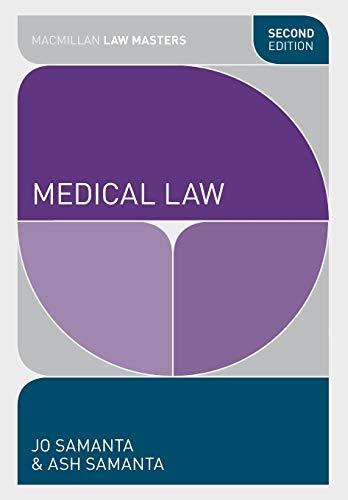Question
Read the scenario below and answer the following questions. Walkerton, Ontario is a small town with a population of 10,000 people. Walkerton's drinking water is
Read the scenario below and answer the following questions.
Walkerton, Ontario is a small town with a population of 10,000 people. Walkerton's drinking water is supply by a series of wells that are located throughout the town. Each well is tested and treated daily by an Engineer from the Public Utilities Commission before it is pumped to people's homes. In May 2000, Walkerton's water supply became contaminated by E Coli bacteria causing more than 2,300 people to become seriously ill and 7 people died. Well #5 was identified as the source of the contamination because it was a shallow well that was close to a cattle farm. There had been a lot of rain the week before the contamination occurred and manure from the cattle farm had been washed into the well by the heavy rain. Although every well must be tested and treated daily, it was common practice for the Engineer to sometimes skip testing and treating some wells and instead record false readings and create false samples using bottled water. Eight days after the contamination occurred, the Engineer decided to release a large amount of chlorine into the water supply because people were getting sick and started complaining about the water to the Public Utilities Commission. For eight days, the people of Walkerton were drinking and using contaminated water without knowing about it. A "Boil Water Advisory" was issued on the ninth day but some people didn't hear about the advisory and continued to drink and use the contaminated water. An inquiry was called by Ontario's Ministry of Environment to determine if charges should be laid against the Engineer who was directly involved with the testing and treatment of the wells.
Did the Engineer fail to protect the environment, health, and well-being of Canadians?
Explain why or why not.
Did the Engineer fail to prevent pollution and fail to address exposure to potentially dangerous chemical substances?
Explain why or why not.
Did the contaminated water meet the criteria for being toxic or high risk?
Explain why or why not.
Should the Engineer be held responsible for failing to properly test and treat the water from Well #5? Explain why or why not.
If the Engineer had thoroughly tested the water and detected the contamination early, should the Engineer have reported the risk to the Public Utilities Commission or Ontario's Ministry of Environment or both?
Explain why or why not.
Did the Engineer violate any of their Duties to Society, Employers, Clients, Colleagues, Employees, the Engineering Profession, or to himself? Identify which Duties were violated, which weren't?
Explain why or why not.
Step by Step Solution
There are 3 Steps involved in it
Step: 1

Get Instant Access to Expert-Tailored Solutions
See step-by-step solutions with expert insights and AI powered tools for academic success
Step: 2

Step: 3

Ace Your Homework with AI
Get the answers you need in no time with our AI-driven, step-by-step assistance
Get Started


